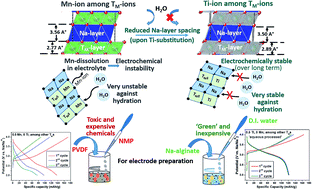Water-stable O3-type layered Na transition metal oxides enabling environment friendly ‘aqueous processing’ of electrodes with long-term electrochemical stability†
Abstract
NaxTMO2 type [TM: transition metal(s)] ‘layered’ oxides, having an initial Na-content (x) of ∼1 (i.e., ‘O3’), are important as potential cathode materials for upcoming Na-ion battery systems. However, among other problems (viz., phase transformations during Na-removal/insertion, TM-dissolution etc.), such oxides suffer from severe instability against hydration in a generic sense, which in turn, negatively impacts the stability, electrochemical performances and environment/health friendliness. Against this backdrop, we have designed a composition (viz., combination of TM-/non-TM-ions) to address the aforementioned problems, in particular, air/water-instability. Partial/complete substitution of Ti-ions for Mn-ions eliminated the presence of Mn3+ (which dissolves in electrolyte) at the particle surface, suppressed the increment in impedance (as well as voltage hysteresis) during electrochemical cycling and, thus, significantly improved cyclic stability. More importantly, the air/water-stability improved drastically, such that no phase/structural change occurred even after 40 days of air-exposure and 12 h of stirring in water, unlike for predominately Mn-ion containing counterparts, which progressively evolved O′3 and P3 phases. In fact, water-stability enabled the usage of environment/health friendly, as well as less expensive, ‘aqueous-binder’ (viz., Na-alginate) and water (as solvent) for electrode preparation. The as-developed environment/health friendly ‘aqueous-processed’ electrode also exhibits excellent long-term cyclic stability, with capacity retention being ∼82% after 100 cycles (∼60% after 500 cycles and ∼56% after 750 cycles) at C/5, along with just ∼4% capacity fade over the last 250 cycles investigated (viz., cycles 500–750). Such an elimination of requirements for toxic/hazardous-cum-expensive ‘non-aqueous’ solvents/binders for electrode preparation and the associated learning, in terms of suitable combinations of TM-/non-TM-ions for these oxides in the pursuit of desired structural features, are significant steps towards the development of alkali metal-ion batteries in general.



 Please wait while we load your content...
Please wait while we load your content...